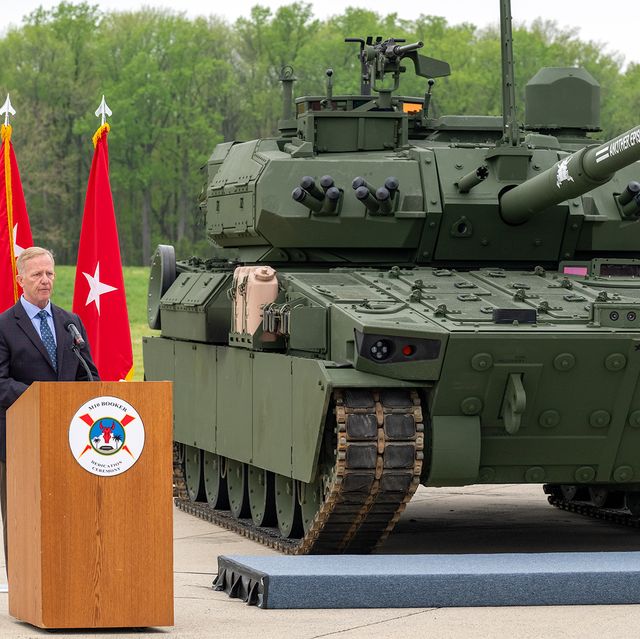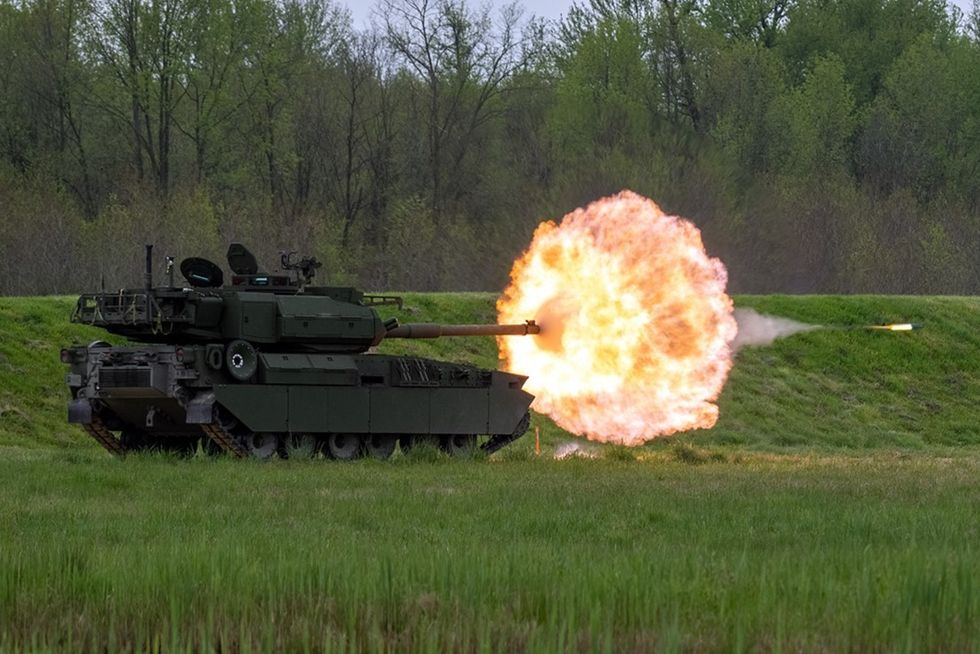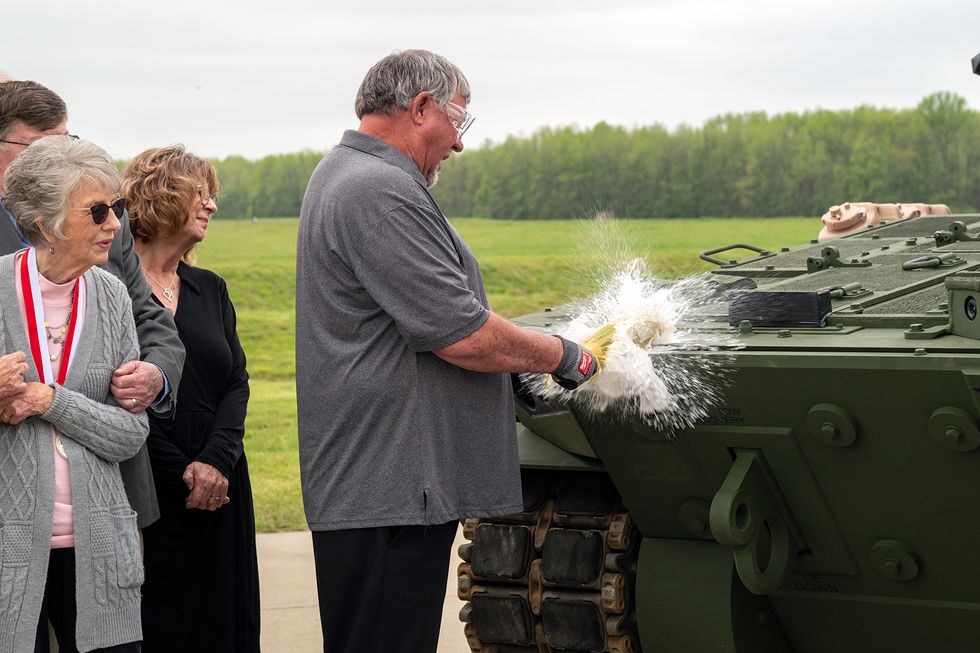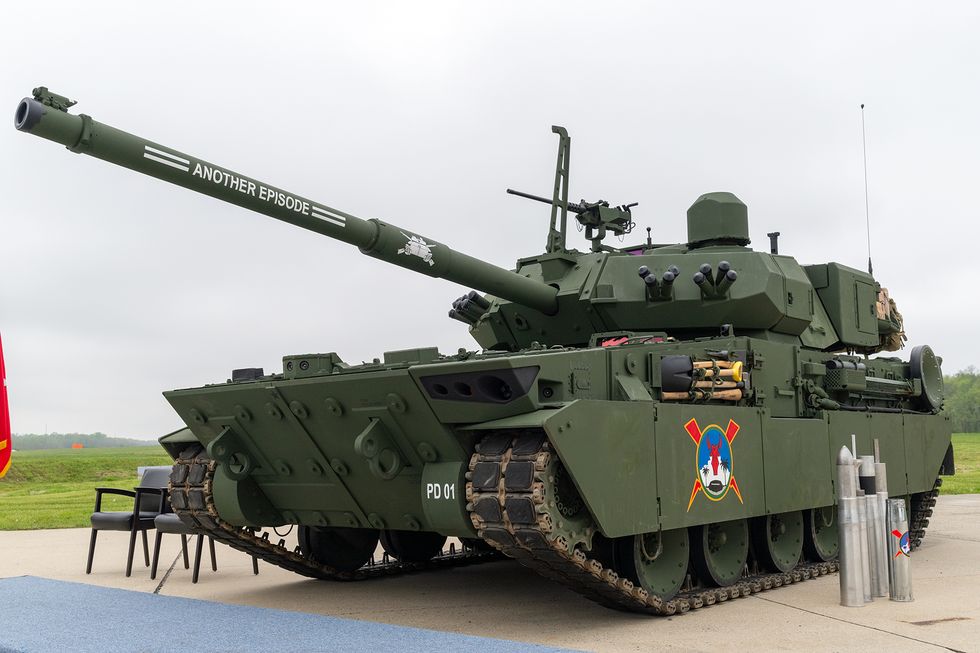- The Army officially took delivery of the first M10 Booker Combat Vehicle.
- The Booker is designed to give extra punch to lightly armed brigade combat teams.
- The first guns are headed to the 82nd Airborne Division, with other units to follow.
The M10 Booker Combat Vehicle is officially part of the U.S. Army. The Booker—which outwardly resembles a small tank—is designed to beef up Army light infantry, paratrooper, and mountain units, and includes a round that spits thousands of tungsten balls at lightly armored enemy forces.
Drafted
The M10 Booker was inducted into Army service on April 18th, 2024 in a ceremony at Aberdeen Proving Ground, Maryland. The families of two soldiers after whom the Booker was named—Pvt. Robert D. Booker and Staff Sgt. Stevon A. Booker—were both on hand to witness the dedication. Both families later dedicated the first vehicle with bottles of champagne broken across the front of the hull. The vehicle is named “Another Episode,” after Staff Sergeant Booker’s personal tank in Operation Iraqi Freedom.
The first M10 Bookers are headed to the Army’s main crisis response division, the 82nd Airborne Division. The 82nd’s new Booker Combat Vehicles will go to 3rd Battalion, 73rd Cavalry Regiment. The battalion will likely be reflagged as the division’s traditional armor unit, 3rd Battalion, 73rd Armor—a reflection of a change in the unit’s mission from reconnaissance to infantry support. 3-73 Armor has, until recently, operated LAV-25 light armored vehicles on loan from the U.S. Marine Corps as a stopgap measure until something like the M-10 was fielded. The 82nd will field a company of about 15-20 Bookers by the summer of 2025, with a full battalion to follow.
The Army is projected to buy 504 M10 Bookers by 2035. The vehicles will be used to establish armored battalions in light infantry divisions and brigades that otherwise have no armored vehicles. After the 82nd Airborne, other candidate units include the 10th Mountain Division, 11th Airborne Division, 25th Infantry Division, 29th Infantry Division, and 173rd Airborne Brigade. A brigade might receive between 15 and 20 Bookers, while a division could receive up to 45-60.
Named For Heroes
The M10 Booker is part of a growing trend of the U.S. Army naming armored vehicles not after generals—like the M4 Sherman tank or M2 Bradley fighting vehicle—but after noncommissioned officers. The M10 follows the 1980s-era M247 Sergeant York air defense vehicle (canceled during development), and the currently serving M1126 Stryker infantry combat vehicle.
The Booker is named after two Army noncommissioned officers who died in battle. The first, Pvt. Robert D. Booker was a member of the 133rd Infantry Regiment, 34th Infantry Division. According to Pvt. Booker’s Medal of Honor citation, in North Africa on April 9th, 1943, he advanced and fired on two enemy machine gun nests with his own light machine gun, despite heavy enemy fire. Booker silenced one nest before being wounded twice—the second time mortally. Booker then rallied his own squad and directed their fire before dying of his wounds.
Sixty years later, Staff Sgt. Stevon A. Booker—a member of 1- 64th Armor, 2d Brigade Combat Team, 3rd Infantry Division—earned the Distinguished Service Cross during Operation Iraqi Freedom. On April 5th, 2003, SSgt Booker directed fire against Iraqi forces during an advance towards Baghdad Internati al Airport, while exposed to enemy fire, all the while leading his troops. He was credited with destroying an enemy troop carrier. Booker was mortally wounded during the eight kilometer advance.
Assault Gun
The M10 Booker resembles a tank, with a conventional tank layout of an armored chassis, armored turret with main gun, and a tracked movement system. Despite the resemblance, the Army strenuously maintains that the M10 is not a tank, and refers to it as the Booker Combat Vehicle, or BCV.
The M10, at approximately 38-42 tons, is significantly lighter than the 73-ton M1A2 SEPv3 main battle tank. Traditionally, a vehicle like the M10 was considered a light tank. Light tanks are generally used for reconnaissance, screening, and probing enemy positions. The modern battlefield, however, is so packed with threats—from loitering drones to anti-tank missiles and handheld anti-tank weapons—that the light tank concept is obsolete.
Instead, the M10 is more like the assault gun concept pioneered by the German Army in World War II. Assault guns are armored vehicles that lend their main gun firepower to the infantry to support them in attack and defense, and use their mobility to rush from one trouble spot to another. In an attack, the BCV would use its 105mm main gun to destroy enemy bunkers, machine gun nests, fortifications, and other defenses that could hold up the advance of foot-bound infantry. In a defensive role, Bookers would use their mobility to rapidly respond to an enemy thrust, positioning themselves along the axis of advance.
The M10 Booker’s M35 main gun likely uses the same 105mm ammunition as the obsolete M60A3 Patton, early models of the M1 Abrams, and the M1128 Mobile Gun System. That would give it the capacity to fire one of the deadliest anti-tank rounds in the Army’s inventory—the M900 Armored Piercing, Fin Stabilized, Discarding Sabot Tracer round. The M900 is a large, dart-like projectile tipped with depleted uranium that is fired from a 105mm gun. It is likely capable of penetrating, for example, the armor of current Russian tanks and all other Russian armored vehicles.
Another round, the M1040, is a blunt-nosed 105mm shell filled with over 2,000 tungsten spheres. The M1040 canister round is designed to incapacitate or kill half of a 10 person enemy infantry squad at ranges of 100 to 300 meters. The Army describes the effect as “like a shotgun round,” with the spheres projecting outward from the barrel of the gun in a cone-shaped arc. The M1040 is not in production, but stocks probably exist for wartime use. Canister rounds are used infrequently due to the excessive wear and tear they inflict on the gun barrel.
The M10 Booker will be the infantry’s own armored vehicle—one designed to support light infantry in both attack and defense. Ground pounders will retain all the traditional strengths of the infantry, but reinforced with a fast-moving, quick-hitting armored vehicle. The first company of 15-20 Bookers will be operational with the 82nd Airborne Division by 2025.

Kyle Mizokami is a writer on defense and security issues and has been at Popular Mechanics since 2015. If it involves explosions or projectiles, he's generally in favor of it. Kyle’s articles have appeared at The Daily Beast, U.S. Naval Institute News, The Diplomat, Foreign Policy, Combat Aircraft Monthly, VICE News, and others. He lives in San Francisco.
















